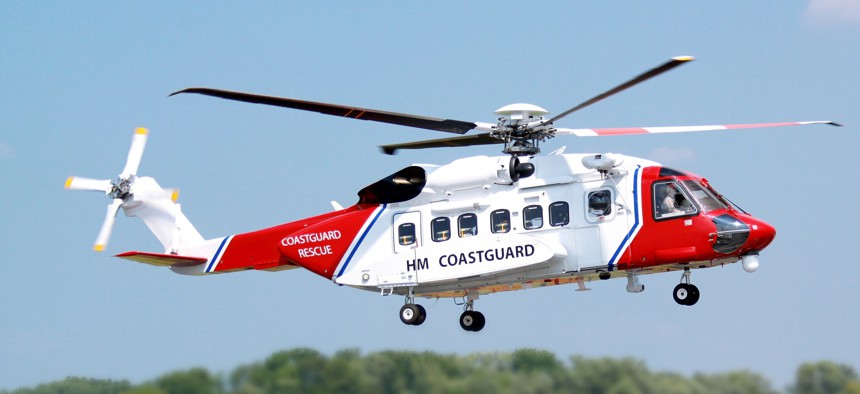
The first S-92 helicopter delivered to Bristow Group for search-and-rescue service in the United Kingdom seen in September 2014. PRNewsFoto/Sikorsky Aircraft Corp.
With Oil Revenue Down, Commercial Firms Eye Military Business
The companies showed up at a massive naval trade show, ready to work.
As oil prices slide, commercial firms that have relied on the energy sector for work are turning their sights to military business. It’s a reversal of trends; in recent years, defense firms have looked for commercial business to prop up earnings amid a decline in military spending.
“Low oil prices have likely stimulated greater focus on non-energy growth opportunities,” Byron Callan, an analyst with Capital Alpha Partners, wrote in a note to investors this week.
Callan observed that Bristow and Oceaneering, two firms largely associated with the energy sector, had display booths at the Navy League’s annual Sea-Air-Space conference outside Washington this week. The lion’s share of exhibitors at military shows like this are generally focused on defense contracts, whether they are smaller suppliers or defense titans such as Lockheed Martin and General Dynamics.
Houston-based Bristow, by contrast, is the “largest global provider of air transportation to the offshore oil and gas industry,” the company boasts in a brochure. The firm owns more than 450 helicopters and fixed-wing planes and operates commuter airlines internationally. Its operations span the globe, everywhere from the Gulf of Mexico to the North Sea.
“Pretty much everywhere they’re pulling oil and gas out of the ocean, we’re there,” said Paul Mueller, Bristow’s vice president of government solutions.
But the company also has contracts for military work outside the U.S. for flight training, search and rescue and maintenance and repair work. Last year, Bristow took over flying search-and-rescue missions for Her Majesty’s Coastguard, under a contract that runs through 2026. The company hired many former military and civilian pilots to fly those missions, Mueller said.
A year ago, company leaders decided to seek more government work, Mueller said. Since then, its executives have developed a strategy to grow its U.S. and international business.
In the U.S., Bristow is eying work for Navy helicopter training through a similar arrangement to the U.K. Coastguard work, Mueller said. It also sees potential business with the U.S. Coast Guard and Department of Homeland Security.
The civil helicopter market has taken a hit since oil prices began dropping in 2014. Last year, Sikorsky cut 1,400 jobs as demand for helicopters to fly oil workers to offshore rigs has declined. Earlier this year, Honeywell, a major aircraft engine supplier, said it expects 4,300 to 4,800 civilian helicopter deliveries between 2016 to 2020. That’s about 400 fewer than it predicted in its 2015 five-year forecast.
“The current global economic situation is causing fleet managers to evaluate new helicopter purchases closely, and that's why we're seeing a more cautious five-year demand projection compared with previous years,” said Carey Smith, president of defense and space at Honeywell Aerospace.
Despite a decline in military spending beginning in 2011 and the implementation of budget caps in 2013, Pentagon spending has flattened and is expected to slowly tick upward in coming years even if the caps remain in place.
Elsewhere at the show, Sean Stackley, the Navy’s assistant secretary for research, development and acquisition, laid out a lengthy list of new ships and aircraft the sea service will receive or is building in the months and years ahead.
“Yes, we are increasing the size of our Navy, but it’s more than about adding size,” Stackley said. “It’s about adding capability.”
NEXT STORY: Japan Shops Futuristic Sub-Hunter Plane





